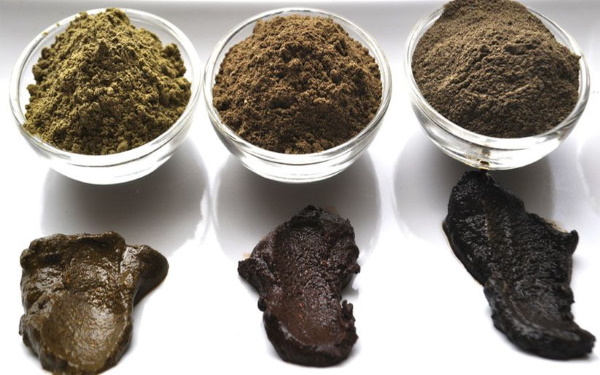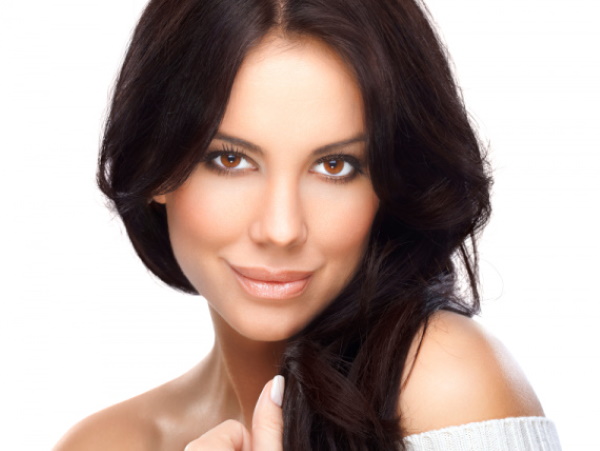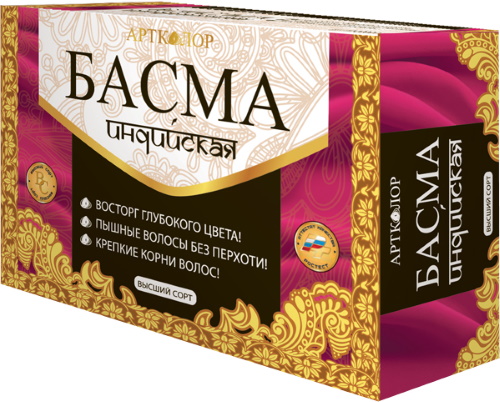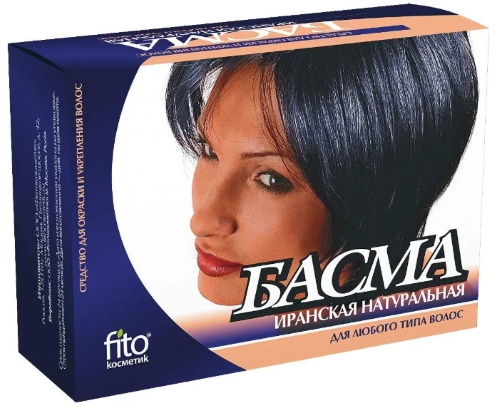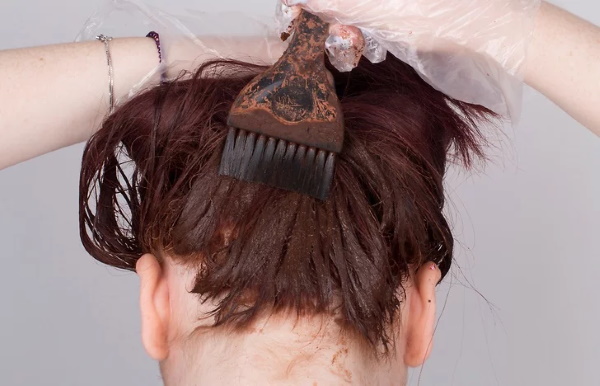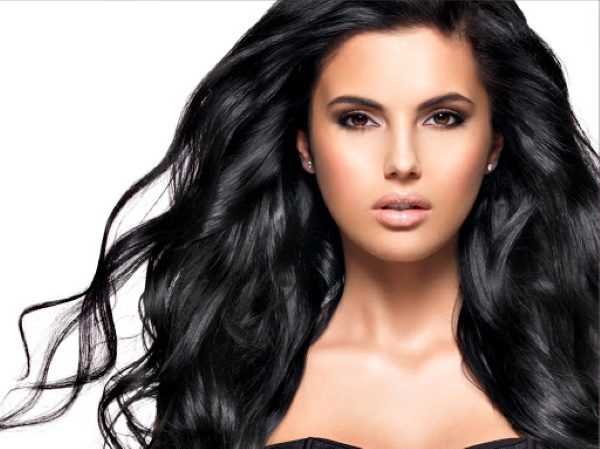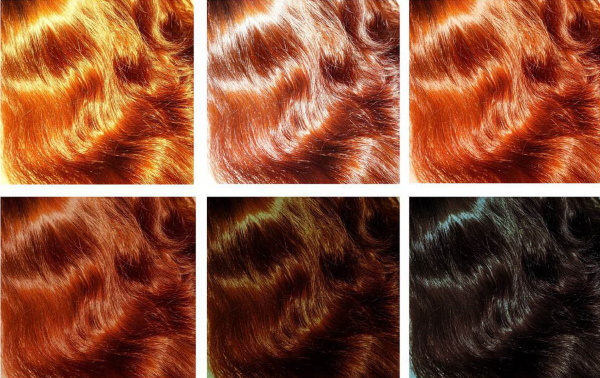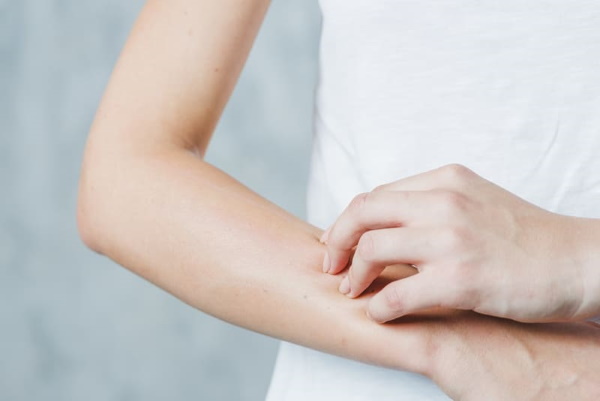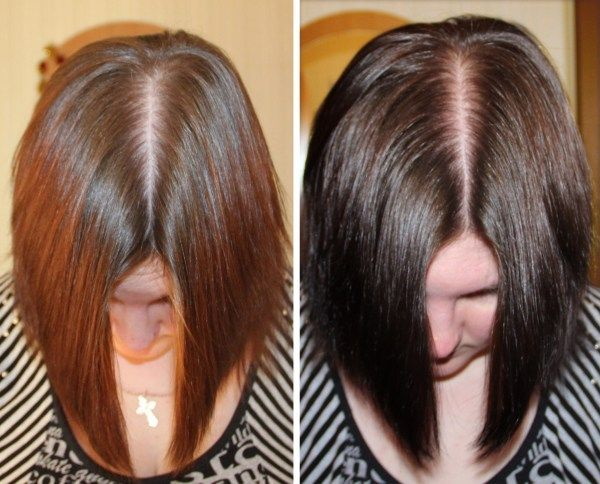One of the most popular coloring compositions for hair, Basma is considered, taught from the leaves of indigo, a flowering plant of the legume family. Reviews note the gentle effect of the natural remedy on the rods and follicles, as well as the ability to achieve an attractive and rich shade of curls.
Composition
The main active ingredient of the natural coloring powder is indican glycoside, which is a colorless water-soluble biochemical compound. On contact with enzymes and weak acids, it breaks down into glucose and indoxyl aglycone molecules.
The latter contain hydrocarbons and nitrogen necessary for the normal functioning of cells. When the indican glycoside is exposed to a mild oxidizing agent, which is the atmospheric air, a coloring pigment is formed, called indigo blue. To obtain a rich dark shade of hair, basma is mixed with henna in various proportions.
The coloring composition of plant origin has a complex multicomponent composition. It is saturated with trace elements and bioactive substances that help strengthen the rods and bulbs.
Basma for hair has collected a lot of reviews. They emphasize that the coloring composition of dried and frayed leaves of tropical indigo gives the curls natural strength and healthy shine.
In addition to obtaining a variety of spectacular and aesthetic flawless shades, Basma helps to get rid of cosmetic imperfections and dermatological defects of the scalp.
The chemical formula of the plant powder contains tannins - high molecular weight phenolic molecules of the aromatic series. They strongly affect organic environments, suppressing the vital activity of pathogenic bacteria, yeasts and molds.
Tannins are typical components of many southern plants. It is they who give the fruit an astringent and tart taste. In basma, phenolic compounds play an important biological role.
In contact with the protein elements of the skin, tannins provoke their partial coagulation. The result is a thin but durable film that protects the epidermis and hair from the effects of destructive environmental factors.
The resinous compounds and plant wax contained in basma serve as natural plasticizers. They make hair pliable, resilient and durable, while simultaneously saturating it with minerals.
Coloring curls with powder from indigo leaves increases their volume, which is considered an undoubted advantage for girls with thin and fragile rods. Basma is rich in vitamins of groups A, C and E.
Such biologically active chemical compounds are necessary for cells of the skin and hair columns for normal proliferation (reproduction). They have antioxidant, fungistatic and anti-inflammatory properties.
In what form is it produced?
On store shelves, Basma can be found in cardboard boxes with a clear print indicating the variety and basic characteristics of the product. Inside the package there is a hermetically sealed polymer bag with a powdery dye composition.
The package includes disposable cosmetic gloves. Basma is available in packs of 25, 50, 100 and 125 g. Depending on the volume of the package, the price of the product varies from 140 to 490 rubles.
The varieties of the product are named after the place of growth of the indigo, from which the coloring composition for hair is made. All product varieties have the same cost.
Indian basma
It is the most sought after and commonly used variety called black henna. In different proportions, Indian Basma provides a variety of tint spectrum and allows you to choose the color of the curls as close to natural as possible.
Thanks to fine grinding, the powder dissolves well in water, lays down in an even layer on the curls, but it is difficult to wash off. The Indian variety has a quick effect, has a pleasant aroma and gives a persistent coloring effect.
Turkish
Powder from the leaves of indigofer, native to Asia Minor, allows you to give curls a wide range of restrained, noble and elegant shades. Turkish basma is preferred mainly by middle-aged women.
Such a product needs a slightly longer exposure time on the hair than its Indian counterpart. Natural paint of Turkish origin, like all other varieties, is used only in combination with henna. Otherwise, the hair will take on a greenish blue tint.
Yemeni
The product gives a deep and rich color, reminiscent of the Arabian night sky. The Yemeni variety, in addition to its expressive aesthetic effect, has many beneficial properties and healing effects.
With its help, you can strengthen the follicles and make the rods elastic.
To enhance the therapeutic effect, eliminate diffuse alopecia, get rid of dandruff, the composition is mixed with:
- essential oils;
- hydrolates;
- herbal powders;
- conditioning components;
- vitamin compounds.
Basma for hair (reviews confirm this) of Yemeni origin in different proportions with henna paints curls in elegant dark brown shades or in an expressive and mysterious color of a raven wing.
Iranian
The product is ideal for quick changes in appearance and aesthetic image. Iranian basma refreshes the look. It provides a wide range of curls - from coppery to anthracite.
Cosmetic product:
- has a tonic effect on the skin;
- improves the functional state of the scalp,
- stimulates the growth of rods;
- prevents brittle strands.
The Iranian variety creates an attractive shine for curls and maintains a normal acid balance in the epidermis layers. The moisturizing effect is especially noticeable when combined with a medicated shampoo or conditioner. It smoothes scales, leaving hair soft and pliable for styling.
Act
The composition of a natural phyto-dye, balanced and rich in useful substances, allows you to radically solve many dermatological and aesthetic problems, as well as achieve a radical change in your own appearance.
The high content of mineral elements in basma with regular use of the product helps to strengthen the rods and prevents their spontaneous loss. Hair loss, called diffuse alopecia, is often caused by vitamin deficiency.
This leads to a weakening of the follicles and the development of their dystrophic state. The process of hair loss is especially activated in early spring and in the autumn-winter period, when there is an acute deficiency of nutrients necessary for the normal functioning of cells.
In addition to a variety of shading solutions, Basma eliminates dandruff resulting from excessive dryness of the skin. Such a negative manifestation does not add attractiveness to the curls and is often accompanied by annoying itching.
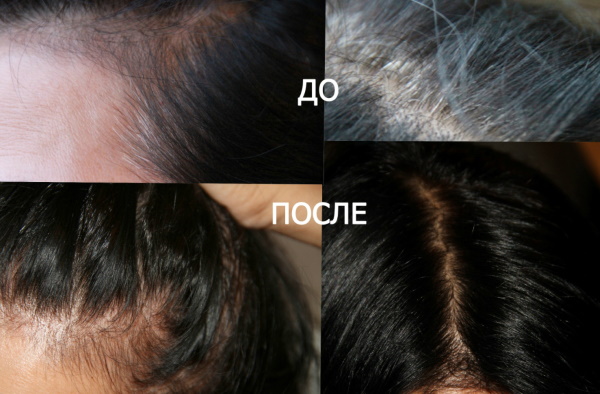
Basma will not help solve this problem with a single application.Regular use of hair dye is required. Vitamin C contained in the herbal preparation has a mild anti-inflammatory and antibacterial effect.
Minerals and tannins nourish the hair columns, stimulate subcutaneous microcirculation of blood, and activate regenerative processes in the cells of the surface layer of the epidermis. Basma normalizes the sebaceous glands. It is effective for normal to oily hair, but poorly suited for pathologically dry hair.
Regular use of a natural herbal product gives curls:
- elasticity;
- elasticity;
- attractive gloss, comparable to the use of cosmetic formulations that contain silicone;
- smooth texture.
Hair dyed with basma is easy to comb, well styled and straightened. A pleasant bonus is the activation of the growth of curls. The tool will especially appeal to girls who want to quickly achieve long and even curls.
Basma for hair is an effective growth activator. This fact is especially noted in reviews by those who regularly use the tool. The product protects the rods from the destructive effects of solar ultraviolet radiation and aggressive external chemical influences.
The vitamins contained in the natural phyto-dye are capable of binding salts of heavy metals and toxic compounds, facilitating their evacuation when flushed. Such a tool will be useful for girls who live in ecologically disadvantaged regions.
Application
There are 2 ways to dye hair with basma - separate and simultaneous. Both methods involve mixing it with henna.
Basma application rules:
- The composition must be diluted immediately before staining.
- Previously, areas of the skin along the hairline must be treated with a fat cream. This will make it easier to wash off the dye
- Always wear complete gloves on your hands. It is not recommended to work with paint without them.
- It is advisable to throw on the shoulders a protective fabric of the appropriate purpose, which is used in beauty salons, or a flap of any matter. A towel, a sheet, an old T-shirt will do.
- After dyeing, it is recommended to put on a plastic cap on the head.
- Basma with henna is mixed in proportions that allow you to get the desired shade (more on this below). The resulting composition is poured with hot water, but not with boiling water. The maximum amount of liquid is 800 ml.
The required consistency is determined individually. The best option is the density of sour cream. The coloring composition is evenly distributed over the surface of the hairline with a cosmetic brush.
Rinse the curls with warm water and shampoo. It is undesirable to use a hair dryer immediately after staining. It is best to let your hair dry naturally.
The separate method of dyeing curls involves sequential processing with basma and henna. First, a composition of indigo leaves is applied. Stand for 30-40 minutes, then wash the hair and dry it.
Only after that, henna is applied to obtain the desired shade. The owner of long hair will have to spend at least 2 hours to complete the process. The simultaneous method involves the joint use of natural dyes.
The proportions are calculated individually, depending on the desired hair color. This method has the obvious advantage that the process is quick. The number of operations compared to the separate technique is much less.
A significant disadvantage is that it is easy to make a mistake with the proportions. Experience and good knowledge of the peculiarities of one's own appearance is required. The entire simultaneous staining procedure takes a maximum of 50 minutes.
Combined in equal quantities henna with basma on fair-haired girls gives an attractive chestnut tint.On the owner of blond hair, this proportion will look like an exquisite shade of milk chocolate.
Basma for hair (reviews especially note the variety of color solutions and dependence on the natural color type), combined with henna in a 1: 3 ratio, gives a delicate and gentle light brown tint.
But this applies only to girls with naturally light curls. Owners of other colors of appearance will not be able to get such a shade. The desired color nuance is determined experimentally.
When mixing basma with henna in a 1: 2 ratio, the hair will be colored in a catchy fiery red shade. On blondes, it will look like a real fox color, and for girls with naturally dark curls, such a composition will give an exquisite and noble bronze tint if you keep the paint on your head for 30 minutes. instead of the prescribed 15.
For those who wish to give their strands a rich and catchy shade of dark chocolate, it is recommended to combine basma with henna in a 1: 3 ratio. The holding time is 15-20 minutes. To obtain a radical black color, the dye composition must remain on the head for at least 1.5 hours.
When preparing a mixture, it is important not to dilute henna with basma in the same bowl. Otherwise, you will not be able to dye your hair normally. This is due to the different susceptibility to high temperatures. In hot water, henna instantly curls up and loses its own coloring properties.
Basma, on the contrary, acquires them in a liquid with a temperature of at least + 70 ° C. Therefore, it is necessary to mix the compositions already diluted to a creamy state.
The radical black color is obtained by a separate processing method as follows:
- Henna is applied first.
- It is kept on the head for about 1 hour, then washed off.
- Next, the strands are treated with basma.
- The longer you keep it, the more black your hair will get.
- If the time basma is on the hair for more than 4 hours, a slight bluish tint will appear.
This technique is universal and suitable for the owner of any natural color type. There are many homemade recipes for coloring henna and basma. They allow you to get extraordinary shades.
It is recommended for fair-haired girls to use mixtures with a predominance of henna. The best option for owners of dark blond hair and brown-haired women is considered to be an equal proportion with a small individual correction depending on the natural color type.
It is advisable for burning brunettes to focus on the predominance of basma to create a brightening effect.
The following special ingredients can be added to such coloring mixtures, which will help to create a completely extraordinary aesthetic solution:
| Component | Estimated cosmetic effect |
| A few drops of red table wine or cranberry juice | Light ruby tint |
| 1 tsp ground coffee | On blondes - a shade of milk chocolate. For owners of other colors of appearance - a rich color of dark chocolate. |
| Beet juice | Noble burgundy color |
| Chamomile | Warm honey-golden tint. Turmeric has a similar effect. |
| Saffron | Original amber overflows |
| Ground table cloves | Reinforces the black color and deepens the chestnut shade with a natural sheen of bark. |
| Cocoa | Gives blonde hair an interesting play of light and shadow. |
| A pinch of table salt | Helps color pigments to fully reveal their aesthetic possibilities. Sea salt additionally strengthens hair follicles. |
| Burdock oil | Useful for dry and loose rods. It will give your curls more thickness and elasticity. As a result, the curls will look voluminous and luxurious. |
| Kefir | Moisturizes the skin, gives the hair a "silicone" shine. |
Adding a few drops of ammonia to the coloring mixture reduces the exposure time on the head.
Contraindications
Basma for hair, reviews of which are mostly favorable, is not recommended for use by girls with an innate tendency to allergic reactions to plant substances.
Natural dye contains organic compounds that have an extremely surface-active effect and are unable to overcome the transdermal barrier. Therefore, the product does not have a systemic effect on the body.
The combination of basma with henna is not forbidden to use even for girls with hypersensitivity of the skin. The only significant contraindication is hypertrophied immune reactions to the inhalation of plant substances.
Before the first use of a cosmetic product, it is strongly recommended to carry out a skin allergy test. The mixture is applied to the wrist, elbow, or forearm. If within 10 min. there was no anaphylactic reaction, the product can be used fearlessly.
It is undesirable not to dye chemically curled hair with a product. They straighten under the influence of basma. During pregnancy and breastfeeding, you can use a natural dye composition, but this must be done with extreme caution.
Side effects
The negative consequences of using the product are extremely rare. With increased biological sensitivity to the components of natural plant composition, a short-term reddening of the scalp, accompanied by slight itching, is possible.
Basma dyeing dries the hair. As a result, their fragility and instability to external stimuli increase. Regular conditioning and gentle, sulfate-free shampoo can help prevent this side effect.
Advantages and disadvantages
The plant dye has many benefits.
The most significant of them are:
- environmental friendliness of the product;
- no harm to the hair, in contrast to chemical dyes;
- healing of wounds and microcracks of the scalp;
- pronounced anti-inflammatory, fungicidal and antibacterial effects;
- protection of the hairy part and epidermis from the negative influence of external factors;
- a variety of color solutions;
- affordable cost;
- strengthening of follicles;
- elimination of dandruff;
- intensification of the growth of curls;
- increasing the density, elasticity, strength and firmness of curls with regular use.
Basma is a universal coloring agent that is compatible with different types of skin and hair. Among the shortcomings, one can single out the difficulty of flushing epidermal tissues from the surrounding curls. To facilitate this procedure, you have to use a fat cream.
A significant disadvantage is that when you first use basma, the result is unpredictable and far from what you want. If you curl your hair after dyeing, it will turn green due to high temperature exposure, which is noted by many reviews. The tool is poorly suited for pathologically dry curls, which should be counted among the obvious disadvantages of the product.
Video about basma for hair
How to dye your hair with basma:

